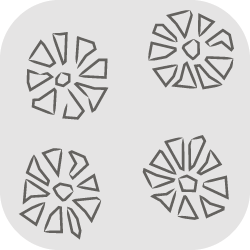- Object Date
- Goryeo 고려 高麗 dynasty (918–1392), second half of the fourteenth century
- Medium
- Hanging scroll; ink, color, and gold on silk
- Dimensions
- Image: 151.1 x 88.7 cm (59 1/2 x 34 15/16 in.)
Overall: 260.6 x 109.9 cm (102 1/2 x 43 in.)
- Credit Line
- The Avery Brundage Collection
- Collection
- Asian Art Museum
- Accession Number
- B72D38
- Provenance
To 1972
Avery Brundage purchased from Mayuyama & Co., Ltd., but the date of purchase is unknown.From 1972
Asian Art Museum
- Apparatus
- Outer box with silk ties; silk wrapper
- Remarks
(Nakano Teruo 中野照男 and Oryu Kazunori 尾立和則, Bunkazai kenkyujo 文化財研究所, Tokyo, 1994) This is a late fourteenth-century work and is in good condition. There are areas which have been touched up, and it was cropped severely when it was remounted.
(Youngsook Park [Pak] 박영숙, undated) There are ten paintings which depict the same subject. Two are in American collections (Freer Gallery and Brundage); seven in Japan; and one small painting on wood is in the Seoul National Museum [National Museum of Korea]. There are differences in style in each of the paintings. All of them employ bright warm colors, such as orange-red and olive-green with the rich use of gold and decorative patterns. However, the two very similar paintings in Matsuo-dera 松尾寺 (dated 1320) and in the Tokyo University of the Arts collection appear stereotyped. Those in Banna-ji 鑁阿寺, in the Tokugawa 徳川 collection, and in Kofuku-ji 広福寺, on the other hand, employ fine lines and delicate colors. The large painting in the Nezu Museum 根津美術館 appears naive and provincial. The painting on panel in Seoul National Museum [National Museum of Korea] (dated 1307) is in the style of Wei-ch’ih-I-seng [Weichi Yiseng] 尉遲乙僧 (mid-seventh–early eighth century). Of the two paintings in the US, the one in the Freer Gallery, though delicate, appears stereotyped by contrast with the lively representation of the Brundage painting, which may be earlier. Nevertheless, because of the scarcity of dated examples, an exact dating is not possible.
- Published References
“Art of Asia Recently Acquired by American Museums, 1972.” Archives of Asian Art 27 (1973–74): 106, fig. 42.
Asian Art Museum of San Francisco. A Decade of Collecting. San Francisco: Asian Art Museum of San Francisco, 1976. Pl. VII.
Mayuyama Junkichi 繭山順吉. Ryūsen shūhō: sōgyō shichijusshūnen kinen 龍泉集芳: 創業七十周年記念 [Mayuyama, Seventy years]. Tokyo: Mayuyama Ryūsendō, 1976. Vol. 2: 129, no. 257.
D’Argence, Rene. Asian Art: Museum and University Collections in the San Francisco Bay Area. Montclair, NJ: Allanheld & Schram, 1978. Fig. 89.
Asia Foundation, Program Bulletin-Special Issue. “Rarities of the Asian Art Museum.” (1978): 15, pl. XVI.
Lyu Mari 유마리. “Goryeo Amita bulhwa ui yeongu – jwasang eul jungsim euro 高麗 阿彌陀佛畵의 硏究 – 坐像을 中心으로.” Bulgyo misul 佛敎美術6 (1981): 42, Fig. 10.
Wilson, William. The Los Angeles Times Book of California Museums. New York: Harry N. Abrams, Inc. Publishers, 1984. 51.
Hong Yunshik 洪潤植. Goryeo bulhwa ui yeongu 高麗佛畵의 硏究. Seoul: Tonghwa publishers, 1984. 34, pl. 6.
Chung Woothak 鄭于澤. “Kōrai jidai no Amida hachidai bosatsu zu 高麗時代の阿弥陀八大菩薩図 [Paintings of Amitabha and Eight Great Bodhisattvas of the Koryo dynasty].” Yamato bunka 大和文華 75 (1986): 24, fig. 11.
Pal, Pratapaditya. American Collectors of Asian Art. Bombay: Marg Publications, 1986. 40, pl. 9.
Bloom, Alfred. “The Western Pure Land.” Tricycle: The Buddhist Review (Summer 1995): 58–63.
Kikutake Junichi 菊竹淳一 and Chung Woothak 鄭于澤, eds. Goryeo sidae ui bulhwa 高麗時代의 佛畵 [The Buddhist paintings of Koryo dynasty]. Seoul: Sigongsa, 1997. Vol. 1: 62–63, pl. 23; Vol. 2: 68.
Kikutake Junichi 菊竹淳一 and Chung Woothak 鄭于澤, eds. Kōrai jidai no butsuga 高麗時代の仏画
[The Buddhist paintings of Koryo Dynasty]. Seoul: Sigongsa, 2000. 62–63, 422, pl. 23.Little, Stephen. “A Korean Gilt-Bronze Sculpture of Kshitigarbha Bodhisattva.” Orientations 34, no. 7 (2003): 55, fig. 5.
Kim, Kumja Paik. Goryeo Dynasty: Korea’s Age of Enlightenment, 918–1392. San Francisco: Asian Art Museum–Chong-Moon Lee Center for Asian Art and Culture in cooperation with the National Museum of Korea and the Nara National Museum, 2003. No. 7.
Yang Heejung 양희정. “Goryeo sidae Amita paldae bosal do dosang yeongu 고려시대 아미타팔대보살도 도상 연구 [A Study of the Eight Great Bodhisattvas in Goryeo Buddhist Painting].” Misul sahak yeongu 美術史學硏究 257 (2008): 84–94.
Koo Jingyung 구진경. “Goryeo Amita paldae bosal do dosang ui seongnip gwa teukjing 고려 아미타팔대보살도 도상의 성립과 특징 [Formation and Feature of Iconography in Koryo’s Amitabha with the Eight Great Bodhisattvas Painting].” Dongasia Munhwa wa yesul 동아시아문화와예술S (2009): 92.
Yu Hong-jun 유홍준. Yu Hong-jun ui Hanguk misulsa gangui 2유홍준의 한국미술사 강의 2 [Story of Korean art, Vol 2]. Seoul: Nurwa, 2010. 493, fig. 5.
Chung Woothak 정우택. “Miguk sojae Hanguk bulhwa josa yeongu 미국소재 한국불화 조사 연구 [Investigation Research on the Korean Buddhist Painting in the United States].” Dongak misulsahak 東岳美術史學 13 (2012): 38, fig. 5.
Lyu, Mari 유마리. Amita bulhwa ui yeongu 아미타불화의 연구. Daejeon: Munhwajaecheong, 2013. 47, fig. 10.
Asian Art Museum of San Francisco. Asian Art Museum of San Francisco: Collection Highlights. San Francisco: Asian Art Museum Chong-Moon Lee Center for Asian Art and Culture, 2018. 216–17.
- Restrictions & Rights
- Copyright with museum
























